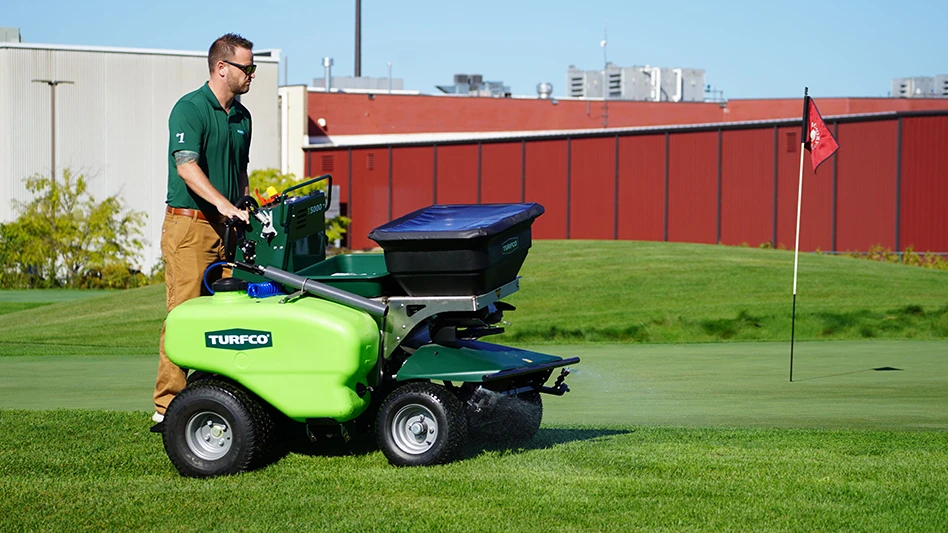It’s difficult to imagine a complete game of golf without 18 tees, fairways and greens. In fact, one might argue it wouldn’t be proper golf. It’s also difficult to imagine a game of golf without a few sand bunkers dotting the landscape. The reason for tees, fairways and greens is obvious, but the reason for bunkers isn’t always so clear.
How does one justify a bunker’s existence? How many should there be? What’s their purpose? What does it cost to maintain them?
Golf course superintendents might have a difficult time answering these questions, which is why bunkers are a sore subject for many of them. Without a clear understanding of objectives, goals and standards for bunkers, superintendents can spend many hours thinking about them and how to please members and golfers. It’s like shooting at a fast-moving target. Let’s look at objectives, goals and standards.
Bunker usage
Bunkers are an integral part of golf course design and have different purposes. Some architects have become famously linked to their bunker designs. Pete Dye and his railroad ties are an example. Some famous golf courses have become linked to their bunkers. Pine Valley and its Devil’s Asshole is an example. Conventionally, bunkers are used for one or more of the following:
- Aesthetics;
- Defining shot value;
- Defining line of play;
- Keeping the ball from a worse outcome; and
- Preventing errant shots from hitting neighbors.
Additionally, there are several unconventional uses that might serve purposes indirectly related to golf:
- For postcards and brochures, which affect sales and promotion;
- To look good on TV; and
- To better a designer’s posterity based on unique or unusual appearances.
In rare instances, bunkers have been known to achieve all three unconventional goals. A good example would be Desmond Muirhead’s shark-teeth-shaped bunkers surrounding an island green at Stone Harbor Golf Club in New Jersey.
Maintenance considerations
Aside from design and usage, maintenance is another important aspect of bunkers. The perception of bunker-maintenance cost is often inflated because of golfers’ constant complaints about sand conditions. Bunkers receive much attention, but a good percentage of that attention might be mental. The only way to determine the exact cost is to document all expenses associated with bunker maintenance. A complete assessment requires the following steps:
1. Document all maintenance costs, including grass surrounds.
2. Identify chronic problems that are adding to the annual maintenance costs. This includes washouts, sand contamination, poor drainage, sand quality and turfgrass quality around the bunker.
3. Determine the necessity of each bunker as it relates to economics, strategy and aesthetics. A golf course architect, working with a superintendent and green committee, should review the design and its impact on the maintenance budget.
4. Develop a long-range plan that includes bunker elimination and/or addition, rebuilding or renovation.
Chronic maintenance problems, which usually can be traced to deficiencies in one or more areas, impact bunker costs, too. It’s also important to understand why bunkers deteriorate to the point where rebuilding is wise economically. Knowing the cause will improve communication during the presentation of the renovation program. Here are four areas:
1. The second law of thermodynamics. All things left to themselves progress from a state of order to disorder. It’s unreasonable to think bunkers will last forever.
2. Improper maintenance. Mechanical rakes have damaged thousands of bunkers to the point where renovation is required around the edges. Some bunkers aren’t constructed to allow bunker rakes to enter or exit, or are too small.
3. Storms and disasters. Heavy rain and floods will wipe out even the best bunker, or at a minimum, remove the sand. In September 2003, Typhoon Maemi cut through Jeju Island on Korea with 120-mph winds and dumped four feet of rain in one day. At The Club at Nine Bridges, all 120 bunkers, which were constructed excellently, were damaged.
4. Chronic construction woes. This area can be the most troublesome and difficult to assess because it’s a slow deterioration of a bunker and surrounding area. Deterioration is often a result of inferior construction methods. Chronic deterioration can be a result of:
- Improper irrigation design of grass surrounding a bunker;
- A lack of or faulty drainage;
- Contaminated sand from constant erosion;
- Atmospheric pollution from dust contaminating sand;
- Continually adding new sand, making a bunker too deep;
- The surrounding area channeling water into a bunker; and
- A wrong bunker design for the social, economic or climatic environment.
Rebuilding or renovation is the best course of action when chronic bunker disorders are identified.
Continually treating symptoms is costly and is part of the annual maintenance cost for bunkers.
Superintendents also might need to prepare for partial or complete construction that will provide long-term benefits and reduce yearly maintenance costs. The table on page 43 shows some construction considerations.
Down the drain
Drainage is an aspect that impacts bunker maintenance considerably. Bunker design should include internal subsurface drainage, internal and surface drainage of water adjacent to a bunker, proper pipe size and drainage exit connections to overall golf course drainage.
Water flows through bunker sand at a high rate, so it’s important to have internal drainage pipe that receives water and transports it at a rapid rate. One of the problems with slotted pipe with small openings is the inability to receive water through the openings. If water can’t enter the openings, it will flow through the gravel surrounding the pipe, carrying fine particles that plug drainage gravel.
For a drainpipe to function properly, one must consider the total area of surface openings in the collector pipe, blockage at the available surface area and water pressure at the interface area.
Responding to this, many companies have introduced more effective methods of draining bunkers. All of these work on the principle of having bigger holes to receive water. Examples include Draincore2, ECS and EZFlow.
The landscape surrounding the bunker also is important for proper drainage. The area should be constructed so water is directed away from the sand. When surface or subsurface water can’t be directed away from the bunker, an intercepting drain should be installed four feet from the bunker edge. Installing an intercepting drain too close to the bunker will destabilize the bunker wall’s integrity.
Even with thoughtful design, most bunkers have a grass or sand side slope. During heavy rain or irrigation, erosion can occur on slope lengths of less than four feet of grass. Sand face erosion depends on precipitation volume, velocity, rate and sand texture.
Sand also affects drainage, and the best sand is one that drains well, has a high angle of repose and has some tendency toward compaction. See the chart above for factors that should be considered when selecting sand. The USGA publication “How to Select the Best Sand for Your Bunkers” is an excellent source.
Construction sequence
Once it’s determined a new bunker is required, advanced planning and attention to construction sequence is needed. Plugged drains, contaminated sand and damage to the golf course can result from out-of-order construction. The following is one recommended construction sequence:
1. Survey and stake according to a detailed drawing with written specifications. Determine cut, fill and soil need.
2. Prepare enough plywood or other material that will support traffic and minimize turfgrass damage.
3. Remove sod around the bunker.
4. Locate drainage exit and place a wire mesh over pipe opening.
5. Remove sand and old drainage. Stockpile contaminated sand for use surrounding the bunker.
6. Detail staking, shaping, and cut and fill as per the plan. Stockpile topsoil and import fill if necessary.
7. Install perimeter irrigation.
8. Stabilize bunker edge using plywood, sandbags or other materials.
9. Compact and smooth bunker base.
10. Install bunker liner following manufacturer’s recommendations.
11. Install sand to a depth of five to six inches, then compact wet sand.
Subsurface preparation
Look at steps nine and 10 more closely. Before filling a bunker with sand, its subsurface has to be compacted. If soils are rocky or compaction isn’t possible, clay soil can be used as a base. For conventional bunkers with a flat bottom and a slim chance of erosion, compacted clay should suffice.
Combined with good drainage, a compacted clay bottom should maintain its integrity for many years. For bunkers in moderate to high rainfall areas with expansive or partial sand faces, additional subsurface treatments can prevent future sand contamination.
Another method of stabilizing the base is applying synthetic polymers, such as liquid polyurethane, which are sprayed on the subsoil to help stabilize soils and prevent sand contamination.
Once the base is established, liners are installed. Liners have been used in bunkers for many years. Early liners were plastic or woven materials that gave way to nonwoven geotextile liners such as Trevira Spunbound, a porous polyethylene fabric. Nonwoven, needle-punched fabrics have questionable long-term performance qualities, especially in the area of water permeability. Another disadvantage of nonwoven liners is their potential to be snagged by bunker rakes. Older liners helped prevent contamination but did little to prevent erosion or sand slipping.
Recently, a number of geosynthetic bunker liners have been introduced. The liners come in various thicknesses, from about 0.25 of an inch to thicker than 1 inch, and are manufactured from man-made materials. Bunker liners serve two important purposes:
1. To prevent contamination from underlying soils by forming a physical barrier between the sand and subsoil; and
2. To reduce erosion on steep sand faces. Water flows through the liner, to the subsoil, reducing sand slipping/erosion. Liners provide a rough surface, increasing the sand’s angle of repose, allowing a steeper sand face without erosion.
All sands have an angle of repose. When sand is piled on the ground, there’s a maximum angle of the pile that can’t be exceeded. One factor that affects the angle of repose is the coefficient of friction at the base. Sand piled on glass will achieve a lower angle than sand piled on a rough surface. Another factor is moisture. Sand with the correct moisture-holding capacity will achieve a higher angle than very dry or very wet sand. Angular sand will also achieve a higher angle.
Get control
It would be nice if we could return to the days of yesteryear when bunkers were primitive and feared greatly. Nowadays, bunkers are tame and domesticated, and superintendents are expected to groom and care for them. As a result, bunkers require money. This year, superintendents should make it their goal to reduce mental stress by getting control of those costly bunkers. GCN
Jim Connolly is president of JCC, Ltd. A former USGA agronomist, he’s a consultant and can be reached at jim@jccturf.com.
Get curated news on YOUR industry.
Enter your email to receive our newsletters.
Explore the January 2007 Issue
Check out more from this issue and find your next story to read.
Latest from Golf Course Industry
- Atlanta Athletic Club approves funding for master plan
- Maximizing Cultural Practices and Agronomic Benefits with Minimal Surface Disruption
- Real Answers about Spray Nozzle Choices
- From the Course to the Factory: How Customer Insights Drive Innovation
- New & Proven Enzyme Strategies for Sprayable Thatch Management
- Innovating Tomorrow: Wittek’s New Products & Industry Staples
- PBI-Gordon introduces new field development team
- The Cabot Collection announces move into course management





